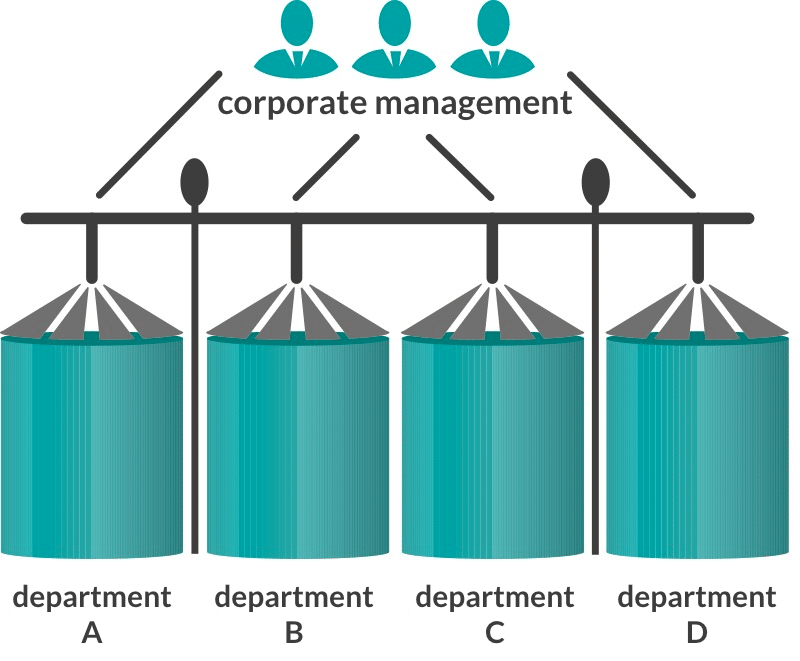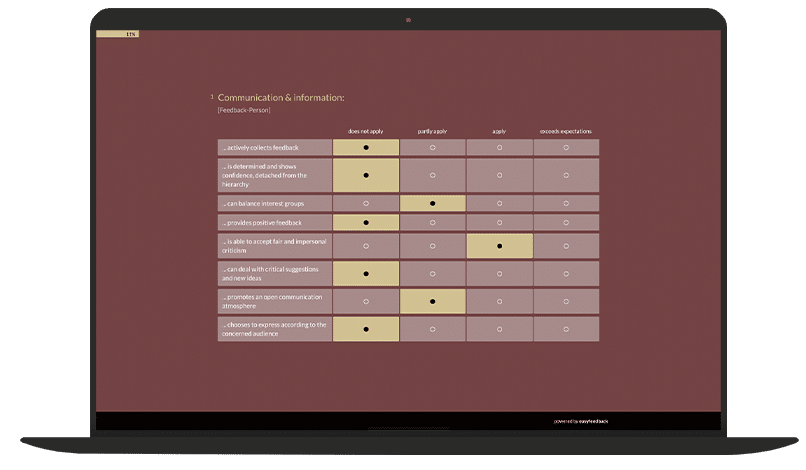Tip 1: Break out of silo thinking
The term silo thinking describes a strongly pronounced departmental thinking and is the biggest enemy of fruitful collaboration.
Of course, it makes sense to divide a complex company into different departments with different responsibilities. No question about it.
But the division into departments also contributes to increasing silo thinking. With all its detrimental effects on employee satisfaction and thus the success of the company.

If each department cooks its own soup and, for example, keeps valuable insights into customer requirements and needs to itself, this inevitably also reduces the development potential and commitment of individual employees and thus the innovation potential of the company.
That’s why cross-departmental cooperation is a crucial success factor in creating a great customer experience together.
And this can only work if the company’s employees receive recognition and see themselves as part of a strong unit. Therefore, it is of high importance to break out of silo thinking, to align teams and departments and to cooperate with each other.
Almost every department has useful knowledge and insights about customers or efficient ways of working from which other departments could also benefit.
But sometimes useful knowledge is not shared as much as it should be, even within individual departments.
The employer must create an atmosphere that promotes employee engagement and thus enables employee satisfaction in the first place.

To do so, certain patterns of thinking and behavior must be discarded:
- One of the main reasons why knowledge is not shared is a strong competitive mindset – competition for recognition and prestige with superiors.
- Even department heads sometimes have reservations about pushing good ideas from their employees despite their high potential and bringing them to the attention of relevant stakeholders in the company.
As a result, ideas that don’t come from within the company are often simply swept under the rug. - And it is also not an uncommon phenomenon to simply sell the good ideas of one’s employees and colleagues as one’s own and to adorn oneself with someone else’s feathers.
I have experienced this myself several times and can tell you a thing or two about how demotivating and conflict-promoting such unfair behavior on the part of colleagues can be.
To permanently eliminate silo thinking and competitive thinking, it is advisable to introduce regular meetings of the various departments – about once a month – to share the latest findings, create a common understanding and improve cooperation.

So instead of working quietly on one’s own success, employees should share their knowledge and help their colleagues grow.
Yes, personal success is a fine thing. But in my view, it is much more fulfilling to receive motivational recognition from superiors for your selfless willingness to help, rather than for performing better than the rest of the team.
Tip 3: Communicate at eye level
It is important that employees have an experienced, professional expert as a leader and are well managed within the team.
However, being in a higher position is no reason to look down on your employees and make them feel that they would rather leave the important topics and issues to the supervisors with more professional experience.
Promote employee engagement in a targeted manner
Innovation potential can only be unleashed if employees know that they can communicate with colleagues and especially supervisors at eye level and contribute their own ideas.
To achieve this, you need to give your employees the feeling that they are by no means inferior or weaker than other colleagues and superiors, but that they are taken seriously and treated as equals in every respect.
However, this is not about immediately following every thought and idea of employees and saying yes and amen to everything. What is really at stake here is a respectful and appreciative attitude toward one’s employees.
Unfortunately, many companies still have a long way to go before they have such an attitude.
That’ why company managers in particular should self-critically reflect on whether they are really communicating with their employees at eye level.
Conduct a regular employee survey
In this context, it is advisable to obtain honest feedback from employees, e.g. via an anonymous employee survey regarding satisfaction with their work and the working environment.
360-degree feedback is also particularly suitable for assessing managers. In this method, the strengths and weaknesses with regard to the competencies of managers are assessed from the different perspectives of employees, colleagues, superiors or even customers.

If an employer carries out these measures regularly, it succeeds in gaining valuable insights for improving employee satisfaction.
Tip 4: Form interdisciplinary teams
At the beginning of this article, I already explained how important it is to break out of silo thinking and cooperate across departments.
However, cooperating successfully does not just mean regularly exchanging ideas and sharing knowledge, but going one step further and forming interdisciplinary teams of employees from different departments.
One example:
When it comes to copywriting, in most companies the copywriting assignment goes across the board to the marketing department. The expectation of the colleagues is that high-quality texts are written that guarantee the required degree of relevance for the target groups.
And that’s where the crux of the matter lies. Because especially in content marketing, where it is a matter of conveying advanced knowledge about complex issues to its readers, marketing very quickly reaches its limits.
And that’s exactly when useless marketing blah-blah is created, which (potential) customers can’t do anything with because the content seems learned and lacks the necessary technical depth.
It would also be absolutely utopian to expect marketing staff to develop the same or similar level of expertise as their colleagues in product development, consulting or any other department.
In such a case, marketing needs input from the colleagues and departments in the company where the technical expertise in the subject areas surrounding your products and services is most pronounced.

What that means in this example is that an efficient content marketing team should ideally be made up of employees from different departments in order to be able to meet the high content requirements of customers.
Otherwise, you run the risk that content from marketing only scratches the surface and communicates past the target groups.
Therefore, think beyond the boundaries of departments. Ask yourself what knowledge and skills can be combined by employees from different areas of the company.
With such measures, you promote the commitment of colleagues and this raises the quality of the work results to the next level.
Tip 5: Assign responsibility
One of the biggest motivation-breakers for employees are so-called micromanagers in leadership positions, who spend a large part of their time controlling their employees due to fears and lack of trust.
Micromanagers tend to constantly meddle everywhere because they have difficulty delegating responsibility.
Of course, entry-level employees or employees in junior positions need to be taken by the hand accordingly and their work methods and results need to be monitored more closely in order to get them on track. But that is not what is meant here.
Micromanagement has a long-term effect on employee commitment:
- Not being allowed to take responsibility severely impairs the performance of employees.
If the execution of tasks is prescribed in such detail that they no longer give employees any freedom, this prevents them from thinking and acting independently. - The lack of freedom, in turn, causes motivation to drop and suppresses employee creativity. To avoid this, employees should be able to work independently and in a self-organized manner.
However, this by no means implies that everyone only does what he or she likes and that managers have no insight into what is going on.
Quite the opposite. It is simply a matter of delegating responsibility and thereby increasing the creativity and motivation of employees.
This not only increases employee commitment and employee satisfaction, but also the quality of work results in the long term.
Tip 6: Create transparency and openness
There are many causes for intransparency in companies – first and foremost silo and competition thinking. Sure, you don’t need to know every move made by every employee in every department.
But as mentioned earlier, it is important to exchange information about plans and activities among each other and to check in this context whether there are overlaps and common interests.
But even within departments, the flow of information and communication usually leaves a lot to be desired. Often, you don’t know what colleagues in the same department are currently working on and whether these activities are perhaps relevant to you in one way or another.
To create more transparency, I recommend the use of a Kanban board to use the so-called Scrum framework.
During the daily 10-minute Scrum meeting (Daily Standup), each employee briefly and concisely gives an overview of what was worked on the previous day, what is pending today and whether there are any obstacles.

This way, on the one hand, you have more transparency in the team and, on the other hand, you can clear any obstacles out of the way at an early stage.
Scrum is known for creating transparency, promoting togetherness and taking team efficiency to the next level.
Last but not least, it would also be worth considering granting colleagues from other departments access to the Kanban board.
This way, everyone can see which projects, milestones and tasks the respective departments are currently working on and what is planned for the upcoming quarters or stages.
Kanban boards are also an ideal tool for supervisors and micromanagers because they can see at any time what is currently being worked on and what the status of things is.
Tip 7: Allow for mistakes and failures
Mistakes happen. And that’s a good thing. Because as Truman Capote once said:
“Mistakes are the spice that give success its special flavor.”
Of course, we (almost) all have an interest in performing well and being successful with our work. This factor is an essential part of employee satisfaction.
But if something doesn’t go smoothly, it’s important to be able to talk about it transparently and openly, without fear of getting another lecture from your supervisor.
How should you deal with mistakes?
- Transparency and openness are created not only by sharing knowledge and helping colleagues improve their performance, but also by trusting each other and talking openly about mistakes.
This creates what is known as psychological safety. - A trusting work environment that provides psychological security fosters employee motivation and performance. That’s why it’s important to give your employees responsibility.
- However, responsibility also means being allowed to learn. In this context, experimentation with procedures for carrying out work must also be permitted. Naturally, mistakes will happen in the process.
But through continuous experimentation and learning, one gradually approaches the ideal state of the desired work results.
Tip 8: Promoting continuous learning
Learning successes and new insights motivate because they create a sense of achievement on a subconscious level. And what could be better for a company than to have highly motivated employees who love their job because they can develop and grow?
But how do you actually achieve continuous learning success among employees?

It’s clear that high learning success requires much more than sending employees to training once or twice a year.
One important measure I mentioned earlier is the sharing of useful knowledge across departments.
Why is that so important?
- Forcing creative ideas through understanding
It may sound unspectacular, but the better employees understand their employer’s company, the requirements of customers, and also processes and procedures in the company, the better they can contribute creative ideas. - Recognizing potential in the company
The better employees understand the company, the more likely they are to identify weaknesses and unleash innovation potential.
Accordingly, for maximum learning success of employees, it is necessary to break out of silo thinking, share insights and knowledge, communicate at eye level, form interdisciplinary teams, assign responsibility, create transparency and also allow mistakes and failures.
Conclusion: A motivating corporate culture enables employees to perform at their best
You may be wondering where you can start in your company to gradually establish an appreciative and motivating corporate culture?
- First of all, it is important to make supervisors and managers aware of the great importance of such a corporate culture.
- The best way to find out how far your company is from such a winning corporate culture is through honest and anonymous feedback from employees and colleagues. After all, you can only optimize what you can measure.
In order to measure the degree of employee satisfaction and identify relevant weaknesses and optimization potential, I therefore recommend conducting regular employee surveys and 360-degree feedback. - This will enable you to derive concrete optimization measures and prioritize and implement them depending on the severity of the identified weaknesses.
In future employee surveys and 360-degree feedbacks, you will then inevitably notice a positive development in the measurement results for satisfaction over time.
Provided you know where the shoe really pinches with your employees and colleagues. One thing should be obvious:
If you don’t know or even ignore the true needs of your employees, you are consciously or unconsciously sabotaging the success of your company. After all, success depends to a large extent on how satisfied employees are.
Employees who love their job and are enthusiastic about it develop creative ideas and are committed to optimizing work processes and improving cooperation.
More about employee satisfaction
- Employee Satisfaction: Everything you need to know!
- Measuring employee satisfaction: Methods & key figures
- 5 Models and theories for employee satisfaction
- Employee satisfaction vs. Employee motivation: correlation and differences
- 5 companies that have increased their employee satisfaction
- Example of an employee satisfaction survey





